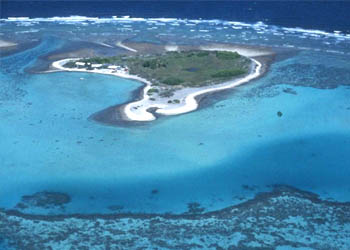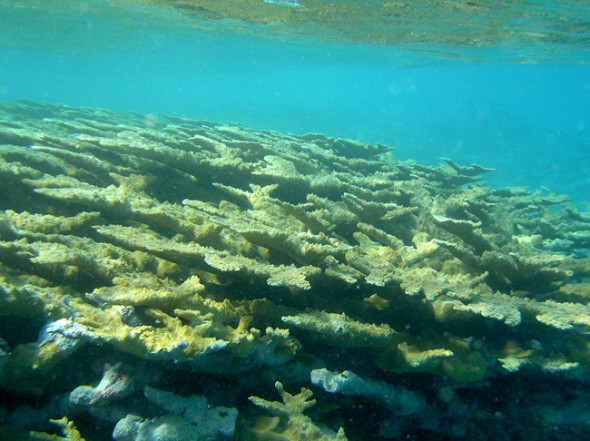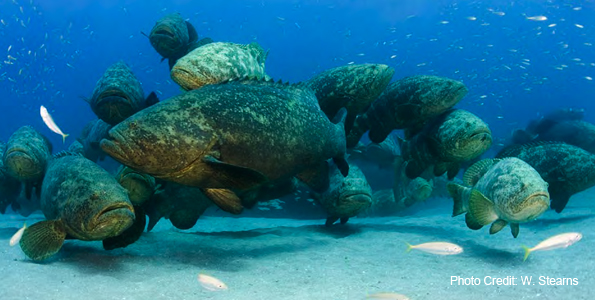What was the world like back in the day? Are the fantastic stories all just legends?
With the notable exception of Jacques Cousteau, few people were taking pictures of the undersea world a few decades ago, not only because the technology was more difficult and expensive and less available, but also because we tend to take things for granted that we see every day. Who would have dreamed that the impenetrable thickets of living elkhorn coral that lined most every fore reef in the Caribbean would be gone in a few short decades? Or the big groupers?
But there are those who remember. Now the United Nations University has assembled a booklet with the haunting memories of those who were there, available here in PDF form. Some excerpts:
“The tragedy of recent coral reef decline is that too few people actually know what coral reefs are supposed to be like, and too few of those who now study reefs witnessed what coral reefs used to be like decades ago.” (Peter Sale and Alina Szmant)
 “I was captivated immediately. The reef itself was nearly as large as Heron Reef and lush with coral. The lagoon, particularly rich in patch reefs, was ponded at low tide. The island was silent, because there was no generator, no tractors, no machinery of any kind rattling away preserving the veneer we call civilization. And it smelled clean and bright, primarily because there were no noddy terns or mutton birds and only three people on it – five when we stepped ashore. The One Tree Island Field Station consisted of three shacks built of corrugated steel over wooden frames, held to the ground like tents by steel cables from eaves to stakes pounded into the rubble ground. They had rubble floors, kerosene fridges, stoves and lanterns, and were comprised of Ted’s Hut, the Living Hut, and the Lab Hut. The latter had a rear alcove known as the honeymoon suite (don’t ask), as well as about 2 m of lab benches. And 3 m from the Living Hut doorway was the lagoon, and boats waiting to be used. As I lay in my top bunk that evening, listening to the wind whistle through the gaps in the wall, I dreamed about reefs and ocean and solitude. I did not know that One Tree was going to become my primary field site for the next 14 years. Later that year, the University of Sydney paid the Australian Museum $1.00 for the facilities and boats, the lease on the island was transferred, and I found myself Ted’s new boss. Ted knew way more than I did about his job (keeping boats and machinery running in spite of scientists, while trying to keep us scientists out of trouble), and communication was limited to cables delivered via the Royal Flying Doctor Service short wave system, or by phone if Ted happened to be on Heron Island. So, I governed Ted with the lightest hand possible! We turned One Tree into a place where graduate students could live on a reef, and where there was nothing to do except dive.” (Peter Sale, One Tree Island, Great Barrier Reef 1968)
“I was captivated immediately. The reef itself was nearly as large as Heron Reef and lush with coral. The lagoon, particularly rich in patch reefs, was ponded at low tide. The island was silent, because there was no generator, no tractors, no machinery of any kind rattling away preserving the veneer we call civilization. And it smelled clean and bright, primarily because there were no noddy terns or mutton birds and only three people on it – five when we stepped ashore. The One Tree Island Field Station consisted of three shacks built of corrugated steel over wooden frames, held to the ground like tents by steel cables from eaves to stakes pounded into the rubble ground. They had rubble floors, kerosene fridges, stoves and lanterns, and were comprised of Ted’s Hut, the Living Hut, and the Lab Hut. The latter had a rear alcove known as the honeymoon suite (don’t ask), as well as about 2 m of lab benches. And 3 m from the Living Hut doorway was the lagoon, and boats waiting to be used. As I lay in my top bunk that evening, listening to the wind whistle through the gaps in the wall, I dreamed about reefs and ocean and solitude. I did not know that One Tree was going to become my primary field site for the next 14 years. Later that year, the University of Sydney paid the Australian Museum $1.00 for the facilities and boats, the lease on the island was transferred, and I found myself Ted’s new boss. Ted knew way more than I did about his job (keeping boats and machinery running in spite of scientists, while trying to keep us scientists out of trouble), and communication was limited to cables delivered via the Royal Flying Doctor Service short wave system, or by phone if Ted happened to be on Heron Island. So, I governed Ted with the lightest hand possible! We turned One Tree into a place where graduate students could live on a reef, and where there was nothing to do except dive.” (Peter Sale, One Tree Island, Great Barrier Reef 1968)
“I was barely sixteen in late 1958 when someone loaned me a facemask for a few minutes and I became completely transfixed by what I saw underwater. Soon after, I bought some basic snorkeling gear and went swimming whenever possible on reefs fringing the cays a few km offshore of Port Royal. My companions were recreational spearfishers whose small boats were powered by 10-hp Seagull outboard motors. One knew of some “secret” outcrops that attracted lobsters and every few months when my parents were throwing a party, we’d snare a bucketful for Mum. Parts of Port Royal had disappeared into the harbor during a 1692 earthquake. My initial uncertified diving occurred above a section of the sunken town that had been excavated during a National Geographic-Smithsonian-Link Expedition in 1959. Later that year I joined the Jamaican branch of the British Sub-Aqua Club and learned to scuba. I didn’t dive with them very much because the club only had about half as many 40 cu ft tanks as divers. Lacking underwater pressure gauges, the first group would submerge for a pre-agreed upon depth and time while those of us in the second
group would snorkel above, hoping to have some air left in whatever tank we each received when it was our turn to dive. In my youth I was blissfully ignorant of historical overfishing and oblivious to the absence of big fishes. Instead, I was entranced by the colorful kaleidoscope of small reef fishes like slippery dick, rock beauty and sergeant major. I saw much, but lacked a vocabulary with which to name or describe the creatures growing on the substratum. During this time I wrote a poem and it still exists today because, unbeknownst to me, it was published in an anthology of contemporary Jamaican writing. I may have known little about biology, but it captures the beauty and wonder I felt as the following excerpt illustrates:
In the water I am accepted, suspended, carried along
or free to wander at will; to move among the brittle,
beautiful corals, watching the play of fish fulfills me as
nothing I have ever known on earth.”
(Judith Lang, Jamaica 1956)
“While moving carefully along the reef flat and looking down at the kaleidoscope of colors and shapes in front of us, the coral communities began changing. All of a sudden, raising our eyes to see how far we were from the breaker zone, there it was, a sight I will never forget. An immense virtually monospecific field of tall branching Acropora, nearly half a metre high, extending almost to the reef edge, and as far as one could see left and right! This was the most impressive, bewildering vista I have ever encountered on a reef flat, and to this day I still vividly remember the deep impression it left on me by it sheer size, lushness, and intrinsic beauty. It covered hectares and hectares, and was impossible to cross.” (Michel Pichon, Tulear, Madagascar 1961)
“Thinking back to what the reef looked like in the seventies there is one overwhelmingly clear difference with the way it looks today. In the seventies the whole reef, all surfaces, all dead coral, was clean, all substratum showing the sharp outlines of clean rocky structure. Except for crustose corallines there were no algae in sight apart from for the turfs in the territories of the damselfish. Macroalgae such as Halimeda or Lobophora were completely absent from the reef at the time. The big change in reef substratum in Curaçao, from clear outlines to fuzziness, occurred in 1983-1984 and coincided with the large scale demise of the urchin Diadema antillarum. This changed the reef from a bottom where conspicuous algae were totally absent to a bottom where algal turfs cover all dead surfaces and where macro-algae such as Halimeda are common at intermediate depths and Lobophora covers a significant part of the seaward reef slope. I remember reading literature in the seventies, by respected authors such as Ginsburg and Milliman, pointing out the importance of algae such as Halimeda in reef sediment production, thinking such statements were bizarre. At the time there was no single Halimeda in sight on the Curaçao south coast reefs. I did not see one Halimeda, despite spending thousands of hours diving those reefs.” (Rolf Bak, Curaçao, early 1970s)
“Inspired by F. G. Walton Smith’s book, Atlantic Reef Corals (1948), I ventured to Belize (formerly the British Honduras) in 1959 to observe firsthand what was touted as the great barrier reef of the Caribbean. Thanks to a Mexican fishing ketch hiring divers, I was able to sail and surface dive along the barrier reef for two weeks. At one remote site, I was astonished to observe fields upon fields of vibrant, golden-brown Elkhorn (Acropora palmata) and Staghorn (Acropora cervicornis) corals, the former present on exposed reef fronts and the latter in more protected leeward habitats. Massive and mounding corals, many several meters high, were also abundant, providing shelter for large schools of groupers, snappers and other fishes. The fish biomass taking shelter in the cavities and caverns under these mammoth corals was extraordinary. Spiny lobsters were everywhere and could often be seen crawling over seagrass patches, even during daylight hours. So what impression did this first coral reef experience make on me? It was exhilarating, awesome, and magical. It gave me an incessant visceral urge to learn more about how this magnificent ecosystem came into being and how the interplay of various ecological processes structured its formation. These are the fundamental questions that have driven my research agenda over the past 52 years.” (Peter Glynn, Belize 1959)
“In the summer of 1964, as an 18 year-old freshman at the University of Puerto Rico, I took my first marine ecology course with Peter Glynn and Jack Randall in La Parguera. I was so taken by the richness and colorfulness of the corals and fishes that I changed my major from chemistry to marine biology. I have vivid memories from that time but really had only a limited understanding of what I was seeing. Over the next five years as an undergraduate, a graduate student at Scripps, and a summer in Hawaii with Len Muscatine and Howard Lenhoff, I learned much of what was then known about corals and coral reefs. When I returned to UPR Mayaguez and to La Parguera in 1970, I set out to reconnoiter the extensive and varied coral reefs of the area. I visited many of the larger reefs, diving into the deeper fore reef zone and swimming up the depth profiles until I floundered in the reef crest zone. I made crude drawings of coral distribution and now wish that underwater photography was as easy then as it is now. As I look back through my limited slides taken with my Nikonos II, I regret that I can’t find photographs that adequately illustrate what I clearly remember.” (Alina Szmant, Puerto Rico 1964)



Leave a Reply